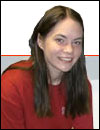Research Reveals Slower-Paced, Non-Attack Political Ads Are Most Attention-Getting
Columbia, Mo. (Dec. 13, 2005) — The most attention-getting and memorable political advertisements are those that use fewer camera angles and scene changes and do not attack other candidates, according to research conducted at the Missouri School of Journalism.
Katherine Roehrick’s research reviewed studies on both cognitive processes (memory, attention, and the like) and 30-second political television advertisements. She and Paul Bolls, her faculty adviser on the project, reviewed more than 70 political ads before selecting 12 to be evaluated by college students of voting age. By studying the number of edits in each broadcast ad and the message style, Roehrick was able to determine how much attention viewers paid to the ad and which ones were remembered.

“What was unique about this particular experiment was that the audio was tested independently from the visual elements,” said Bolls. Bolls, an assistant professor, is one of the primary investigators in the School’s PRIME (Psychological Research on Information and Media Effects) Laboratory. Roehrick, a senior advertising student from Kansas City, will present her findings to state legislators during the 3rd annual University of Missouri System Undergraduate Research Day in Jefferson City next spring. She will be the first journalism student to present at this event. Roehrick is one of 20 University of Missouri-Columbia students who will be participating in the day.

“If you look at a political ad, all of the critical message points that a candidate wants the audience to remember are on the audio track,” Bolls explained. Bolls has conducted research on cognitive emotional processing of media for more than 12 years.
Previous studies on consumer-related products and public service announcements found opposite results, that fast and frequent edits or a negative tone increased attention and memory.
“How political candidates personalize their message for particular audiences and look directly at the camera while talking might account for the different results,” Bolls said. “This is an area for future research.”
Roehrick has submitted her paper to the International Communication Association paper competition. If accepted, she will present at the 2006 conference in Dresden, Germany.
The PRIME lab is equipped to conduct cutting-edge research on how different features of media messages affect attention, emotion and memory. It is one of six active labs housed in Journalism/Mass Communication programs in the country equipped to use psychophysiological methods to study real time responses to messages. Research conducted in the PRIME lab provides a better understanding of how audience members cognitively and emotionally process media. This research can be used to guide production of maximally effective campaign messages.
Updated: April 8, 2020